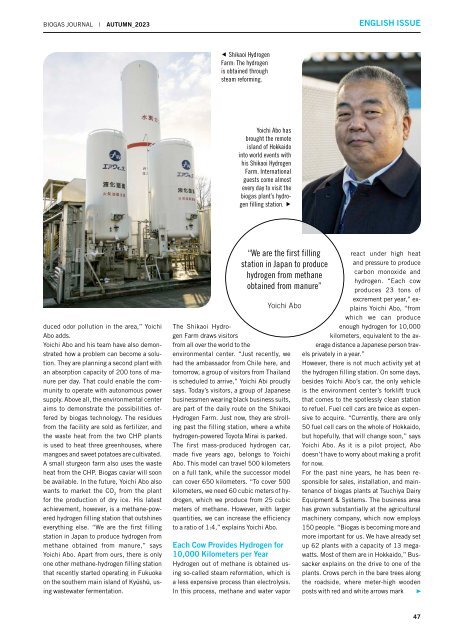Autumn 2023 EN
The German Biogas Association presents its autumn 2023 issue of the English BIOGAS journal.
The German Biogas Association presents its autumn 2023 issue of the English BIOGAS journal.
- No tags were found...
You also want an ePaper? Increase the reach of your titles
YUMPU automatically turns print PDFs into web optimized ePapers that Google loves.
BIOGAS JOURNAL | AUTUMN_<strong>2023</strong> <strong>EN</strong>GLISH ISSUE<br />
Shikaoi Hydrogen<br />
Farm: The hydrogen<br />
is obtained through<br />
steam reforming.<br />
Yoichi Abo has<br />
brought the remote<br />
island of Hokkaido<br />
into world events with<br />
his Shikaoi Hydrogen<br />
Farm. International<br />
guests come almost<br />
every day to visit the<br />
biogas plant’s hydrogen<br />
filling station. <br />
duced odor pollution in the area,” Yoichi<br />
Abo adds.<br />
Yoichi Abo and his team have also demonstrated<br />
how a problem can become a solution.<br />
They are planning a second plant with<br />
an absorption capacity of 200 tons of manure<br />
per day. That could enable the community<br />
to operate with autonomous power<br />
supply. Above all, the environmental center<br />
aims to demonstrate the possibilities offered<br />
by biogas technology. The residues<br />
from the facility are sold as fertilizer, and<br />
the waste heat from the two CHP plants<br />
is used to heat three greenhouses, where<br />
mangoes and sweet potatoes are cultivated.<br />
A small sturgeon farm also uses the waste<br />
heat from the CHP. Biogas caviar will soon<br />
be available. In the future, Yoichi Abo also<br />
wants to market the CO 2<br />
from the plant<br />
for the production of dry ice. His latest<br />
achievement, however, is a methane-powered<br />
hydrogen filling station that outshines<br />
everything else. “We are the first filling<br />
station in Japan to produce hydrogen from<br />
methane obtained from manure,” says<br />
Yoichi Abo. Apart from ours, there is only<br />
one other methane-hydrogen filling station<br />
that recently started operating in Fukuoka<br />
on the southern main island of Kyūshū, using<br />
wastewater fermentation.<br />
“We are the first filling<br />
station in Japan to produce<br />
hydrogen from methane<br />
obtained from manure”<br />
Yoichi Abo<br />
The Shikaoi Hydrogen<br />
Farm draws visitors<br />
from all over the world to the<br />
environmental center. “Just recently, we<br />
had the ambassador from Chile here, and<br />
tomorrow, a group of visitors from Thailand<br />
is scheduled to arrive,” Yoichi Abi proudly<br />
says. Today’s visitors, a group of Japanese<br />
businessmen wearing black business suits,<br />
are part of the daily route on the Shikaoi<br />
Hydrogen Farm. Just now, they are strolling<br />
past the filling station, where a white<br />
hydrogen-powered Toyota Mirai is parked.<br />
The first mass-produced hydrogen car,<br />
made five years ago, belongs to Yoichi<br />
Abo. This model can travel 500 kilometers<br />
on a full tank, while the successor model<br />
can cover 650 kilometers. “To cover 500<br />
kilometers, we need 60 cubic meters of hydrogen,<br />
which we produce from 25 cubic<br />
meters of methane. However, with larger<br />
quantities, we can increase the efficiency<br />
to a ratio of 1:4,” explains Yoichi Abo.<br />
Each Cow Provides Hydrogen for<br />
10,000 Kilometers per Year<br />
Hydrogen out of methane is obtained using<br />
so-called steam reformation, which is<br />
a less expensive process than electrolysis.<br />
In this process, methane and water vapor<br />
react under high heat<br />
and pressure to produce<br />
carbon monoxide and<br />
hydrogen. “Each cow<br />
produces 23 tons of<br />
excrement per year,” explains<br />
Yoichi Abo, “from<br />
which we can produce<br />
enough hydrogen for 10,000<br />
kilometers, equivalent to the average<br />
distance a Japanese person travels<br />
privately in a year.”<br />
However, there is not much activity yet at<br />
the hydrogen filling station. On some days,<br />
besides Yoichi Abo’s car, the only vehicle<br />
is the environment center’s forklift truck<br />
that comes to the spotlessly clean station<br />
to refuel. Fuel cell cars are twice as expensive<br />
to acquire. “Currently, there are only<br />
50 fuel cell cars on the whole of Hokkaido,<br />
but hopefully, that will change soon,” says<br />
Yoichi Abo. As it is a pilot project, Abo<br />
doesn’t have to worry about making a profit<br />
for now.<br />
For the past nine years, he has been responsible<br />
for sales, installation, and maintenance<br />
of biogas plants at Tsuchiya Dairy<br />
Equipment & Systems. The business area<br />
has grown substantially at the agricultural<br />
machinery company, which now employs<br />
150 people. “Biogas is becoming more and<br />
more important for us. We have already set<br />
up 62 plants with a capacity of 13 megawatts.<br />
Most of them are in Hokkaido,” Bussacker<br />
explains on the drive to one of the<br />
plants. Crows perch in the bare trees along<br />
the roadside, where meter-high wooden<br />
posts with red and white arrows mark<br />
47

















